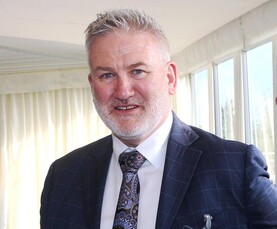DAERA chief scientific adviser, Dr Alistair Carson has suggested that the warming impact of climate change is among a number of factors impacting water quality in Lough Neagh.
Addressing the annual conference organised by the NI Institute of Agricultural Science (NIIAS) last Wednesday evening, Carson said the core problem in the Lough remains nutrient pollution.
However, average water temperature is rising 0.5°C every decade and with that comes an increased release of phosphorus (P) from sediment. When in excess, P causes eutrophication and harmful algal growth.
“The environment is really sensitive to the release of P,” said Carson.
He added that climate change also leads to higher soil temperatures, which increases the mineralisation of nitrogen (N), as well as more extreme weather events. During heavy rainfall there is more leaching of N and P into waterbodies.
In Lough Neagh there is also an invasion of Zebra mussels, which feed on competitors to problem blue-green algae and allow light to penetrate deeper into the Lough.
“It is a very complex ecosystem and when things start to go out of kilter, then dramatic adverse things happen. Climate change is a factor in the whole situation,” said Carson.
He added that in his lifetime, the concentration of carbon dioxide in the atmosphere has increased 30% to reach 421 parts per million (ppm) in 2022. If emissions are not curtailed, it is projected to hit 685ppm by 2050, which will have a devastating impact in various parts of the world.
Ag emissions
In terms of emissions from agriculture, Carson accepted significant progress has been made in driving efficiency, with the likes of the NI dairy industry having one of the lowest carbon footprints per litre. However, he emphasised the importance of also tackling total emissions.
“There is no getting around the absolute levels,” he said.
One of the key technologies that come help reduce emissions are feed additives designed to lower methane released during the rumination process. But if these additives are to be effective, there will have to be really high levels of uptake by farmers, which raises questions around who will cover the costs of using these products.
“There is no viable business model right now. It is an active research area, but there is no economic incentive to feed at the moment,” accepted Teagasc director, Frank O’Mara.
Little appetite to change net zero target
Government civil servants have no option but to put in place relevant policies that will deliver against the targets set out in the NI Climate Change Act, maintained Aileen Lawson from the Ulster Farmers’ Union.
The climate legislation passed by Stormont politicians in 2022 set a target for NI to achieve net zero greenhouse gas emissions by 2050. That target went well beyond the best expert advice from the UK Climate Change Committee (CCC), which had suggested NI could reduce emissions by 82% as part of its “fair contribution” to UK net zero by that date. The latest CCC advice on how NI could achieve net zero points to various “radical actions”, including a significant reduction in livestock numbers.
“Privately among politicians there is a lot of concern, but there is a lack of political appetite for an amendments bill to change those targets,” suggested Lawson.
As reality bites around the cost of net zero, that appetite might change, but in the meantime, Lawson said there is a need for more research around new technologies to reduce emissions and much more to be learned about carbon in soils.
Good water quality an ‘essential’ for farming
Ensuring there is clean water in our lakes and rivers is seen as an “essential” by wider society and by customers for your products, Teagasc director Professor Frank O’Mara told attendees at the NIIAS conference.
“It is an issue for all farmers. The number of waterbodies in Ireland at ‘high’ or ‘good’ status is static – we need to turn around that trend and do it fast,” he said.
Back in March, a new €60m ‘Farming for Water’ project was launched in the Republic of Ireland, with €50m of the overall fund earmarked to support around 15,000 farmers to undertake measures such as fencing off waterways or putting in riparian strips.
According to O’Mara, a “key part of the programme” will involve providing farmers with data on water quality taken from monitoring stations in their local area.







 This is a subscriber-only article
This is a subscriber-only article










SHARING OPTIONS: